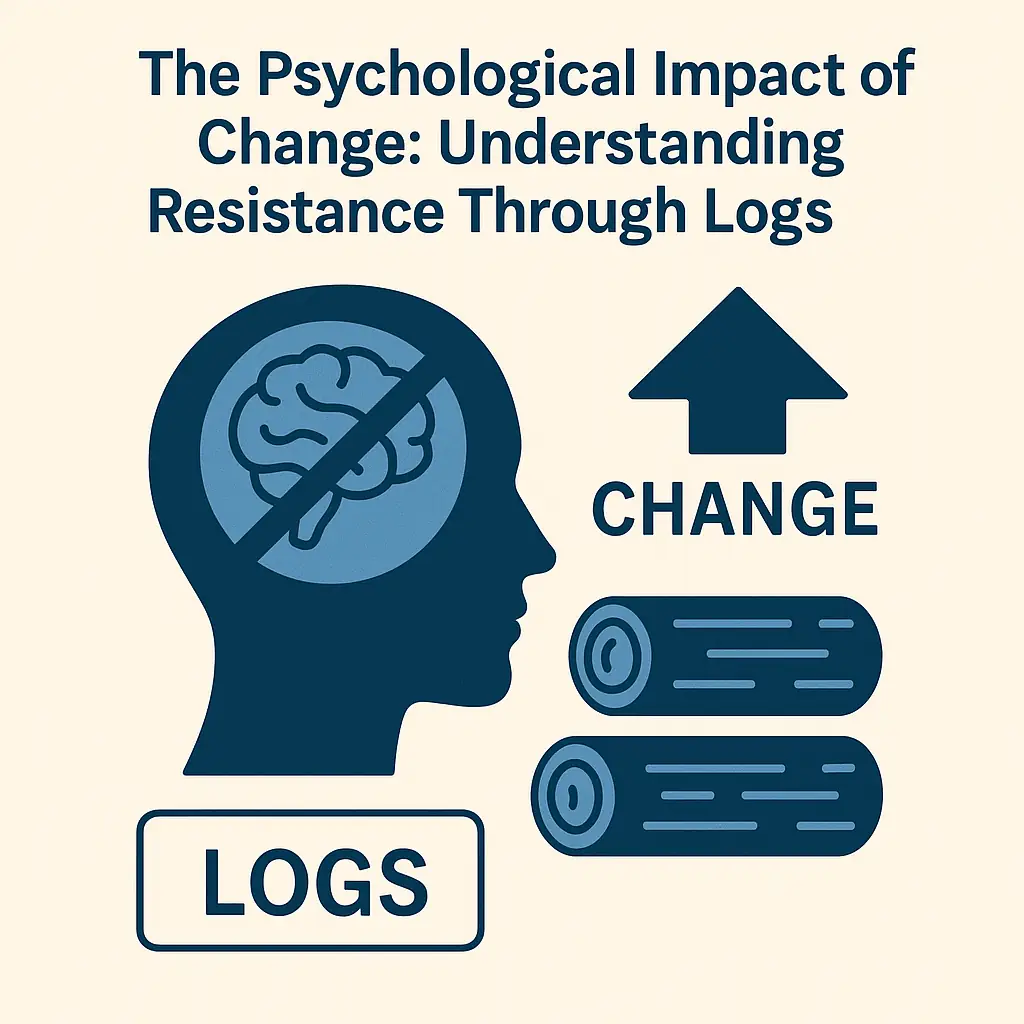Introduction to Change Management Logs
Change management logs are essential tools in project management that serve to track and document changes throughout the lifecycle of a project. These logs provide a structured approach to managing alterations, ensuring that all modifications are recorded systematically. A change management log (CML) captures critical information such as the description of the change, reasons for the change, potential benefits, estimated costs, and the impact on the project. This documentation is crucial for maintaining clarity and transparency among stakeholders, as it allows for informed decision-making and effective communication throughout the project [12].
The importance of documenting changes in a project cannot be overstated. Change logs not only serve as a historical account of modifications, fixes, and improvements but also play a vital role in managing stakeholder engagement. By providing a clear overview of what changes have been made and why, change logs help to foster trust and collaboration among team members. They encourage the development of corrective action plans and facilitate discussions around the implications of changes, thereby minimizing resistance and enhancing acceptance of new initiatives [11][15].
Understanding the psychological aspects of change within teams is critical for change managers and organizational psychologists. Resistance to change is a common phenomenon, often stemming from a lack of awareness or understanding of the reasons behind the change. By utilizing change management logs, leaders can identify patterns of resistance and address them proactively. For instance, if a particular change consistently meets with pushback, the log can help analyze the underlying concerns and facilitate targeted communication strategies to alleviate fears and build support [4][7].
Change management logs are not just administrative tools; they are instrumental in navigating the psychological landscape of change within teams. By documenting changes and understanding the resistance that may arise, change managers can create a more supportive environment that encourages acceptance and fosters a culture of adaptability.
Understanding Resistance to Change
Understanding resistance to change is crucial for successful implementation and adoption of new initiatives. Resistance can manifest in various forms and is often rooted in psychological factors that influence team dynamics. Change logs serve as a valuable tool in identifying and addressing these resistances, allowing change managers and organizational psychologists to navigate the complexities of human behavior during transitions.
Types of Resistance: Active vs. Passive
Resistance to change can be categorized into two primary types:
- Active Resistance: This form of resistance is overt and can be seen in behaviors such as vocal opposition, refusal to comply, or active sabotage of change initiatives. Individuals exhibiting active resistance are often more visible in their dissent, making it easier to identify and address their concerns.
- Passive Resistance: In contrast, passive resistance is subtle and may manifest as a lack of engagement, procrastination, or silent discontent. This type of resistance can be more challenging to detect, as it often involves individuals who do not openly express their opposition but still hinder the change process through inaction or minimal participation.
By utilizing change logs, project managers can track these behaviors over time, identifying patterns that indicate resistance levels within the team. This data can inform strategies to engage resistant individuals more effectively.
Common Psychological Triggers of Resistance
Several psychological factors can trigger resistance to change, including:
- Fear: Fear of the unknown is a significant barrier to change. Employees may worry about their job security, the potential for failure, or the implications of new processes on their daily tasks. Change logs can help identify specific fears expressed by team members, allowing managers to address these concerns directly.
- Uncertainty: Uncertainty about the future can lead to anxiety and resistance. When employees lack clarity about the reasons for change or the expected outcomes, they may become hesitant to embrace new initiatives. Change logs can capture feedback and questions from team members, providing insights into areas where communication may be lacking.
- Loss of Control: Change often disrupts established routines and can make employees feel a loss of control over their work environment. This feeling can lead to resistance as individuals cling to familiar practices. By analyzing change logs, managers can pinpoint instances where team members express concerns about losing control, enabling them to implement strategies that empower employees during transitions.
The Impact of Organizational Culture on Resistance
Organizational culture plays a pivotal role in shaping how change is perceived and accepted. A culture that fosters open communication, trust, and collaboration is more likely to mitigate resistance. Conversely, a culture characterized by fear, hierarchy, and lack of transparency can exacerbate resistance to change.
Change logs can provide valuable insights into the cultural dynamics at play within a team. By documenting reactions to change initiatives, managers can assess whether the organizational culture supports or hinders the change process. This understanding can guide the development of targeted interventions aimed at fostering a more positive environment for change.
Change logs are not merely administrative tools; they are instrumental in understanding and addressing resistance to change. By analyzing the data captured in these logs, change managers and organizational psychologists can gain a deeper understanding of the psychological underpinnings of resistance, ultimately leading to more effective change management strategies.
The Role of Change Management Logs in Identifying Resistance
Change management logs serve as a vital tool for change managers and organizational psychologists in understanding and addressing resistance within teams. By systematically documenting feedback and responses to changes, these logs can provide insights into the psychological impact of change on team members. Here are some key points on how change logs can be utilized to detect resistance:
- Tracking Feedback and Responses to Changes: Change management logs allow organizations to capture real-time feedback from team members regarding new initiatives or changes. This feedback can include comments, concerns, and suggestions, which are crucial for understanding how changes are perceived. By regularly reviewing this feedback, change managers can identify specific areas of resistance and address them proactively, ensuring that team members feel heard and valued [3][10].
- Identifying Patterns of Resistance Through Log Analysis: Analyzing change logs can reveal patterns of resistance that may not be immediately apparent. For instance, if multiple team members express similar concerns or objections in their feedback, it may indicate a broader issue that needs to be addressed. By recognizing these patterns, change managers can tailor their strategies to mitigate resistance effectively, focusing on the root causes rather than just the symptoms [8][11].
- Using Logs to Monitor Team Morale and Engagement Levels: Change logs can also serve as a barometer for team morale and engagement during periods of transition. By tracking sentiments expressed in the logs, change managers can gauge how well the team is adapting to changes. A decline in morale or engagement levels may signal underlying resistance, prompting further investigation and intervention. This proactive approach can help maintain a positive work environment and foster a culture of openness and adaptability [9][12].
Change management logs are an essential resource for identifying and addressing resistance within teams. By tracking feedback, analyzing patterns, and monitoring morale, change managers can create a more supportive environment that facilitates successful change initiatives. This not only enhances the overall effectiveness of change management efforts but also contributes to the psychological well-being of team members during transitions.
Analyzing Change Logs for Psychological Insights
Change management logs serve as a vital tool for understanding the psychological impact of change within teams. By meticulously documenting the change process, these logs can reveal patterns of resistance and emotional responses that are crucial for effective change management. Here are some methods to analyze change management logs for psychological insights:
Techniques for Categorizing and Interpreting Log Entries
- Thematic Analysis: Categorize log entries based on recurring themes such as fear, uncertainty, or enthusiasm. This qualitative method allows change managers to identify common emotional responses among team members, providing a clearer picture of the overall sentiment towards change initiatives [11].
- Impact Assessment: Classify entries by the level of impact on different groups within the organization. Understanding which teams are more affected can help tailor communication and support strategies to address specific concerns [1].
- Frequency Analysis: Track the frequency of specific terms or phrases related to resistance, such as “concern,” “frustration,” or “confusion.” This quantitative approach can highlight areas where resistance is most pronounced, guiding targeted interventions [12].
Identifying Emotional Responses and Their Implications for Team Dynamics
- Emotional Mapping: Use logs to create emotional maps that visualize the range of feelings expressed by team members during the change process. This can help identify clusters of resistance and support, allowing change managers to address issues proactively [14].
- Feedback Loops: Analyze entries for feedback on change initiatives. Positive or negative feedback can indicate the emotional climate of the team, revealing underlying issues that may not be immediately apparent. Understanding these dynamics is essential for fostering a supportive environment [6].
- Behavioral Indicators: Look for behavioral indicators in the logs, such as increased absenteeism or decreased engagement. These can serve as proxies for emotional responses, providing insights into how resistance manifests in team dynamics [10].
Using Data Visualization Tools to Highlight Resistance Trends
- Trend Analysis: Employ data visualization tools to create graphs and charts that illustrate resistance trends over time. This visual representation can help identify critical moments when resistance peaks, allowing for timely interventions [12].
- Heat Maps: Utilize heat maps to display areas of high resistance within the organization. By visualizing data in this way, change managers can quickly pinpoint where to focus their efforts and resources [10].
- Dashboards: Create interactive dashboards that compile key metrics from change logs, such as emotional responses, frequency of resistance, and feedback scores. These dashboards can provide real-time insights into the psychological state of the team, facilitating informed decision-making [9].
By systematically analyzing change management logs through these methods, change managers and organizational psychologists can gain valuable psychological insights that not only help in understanding resistance but also in fostering a more resilient and engaged workforce. This approach not only addresses immediate concerns but also contributes to a culture of continuous improvement and adaptability within the organization.
Addressing Resistance: Strategies Informed by Change Logs
Change management is a complex process that often encounters resistance from team members. Understanding the psychological impact of change is crucial for change managers and organizational psychologists. One effective tool in navigating this resistance is the change management log, which can provide valuable insights into team dynamics and individual responses to change. Here are actionable strategies to mitigate resistance based on insights gained from change logs:
- Creating Targeted Communication Plans Based on Log Findings: Change logs can reveal patterns in employee feedback and concerns regarding changes. By analyzing this data, change managers can develop targeted communication plans that address specific issues raised by team members. For instance, if logs indicate a common concern about job security during a transition, communication can be tailored to reassure employees about their roles and the support available to them. This proactive approach not only clarifies the change process but also fosters trust and transparency within the team, which is essential for reducing resistance [5][6].
- Implementing Training and Support Initiatives Tailored to Resistors: Change logs often highlight individuals or groups who are particularly resistant to change. By identifying these resistors, change managers can implement tailored training and support initiatives that address their specific needs and concerns. For example, if a log indicates that certain team members feel unprepared for new technologies being introduced, targeted training sessions can be organized to build their confidence and competence. This personalized approach not only helps in alleviating fears but also empowers employees, making them more likely to embrace change [3][12].
- Fostering a Culture of Openness and Feedback to Reduce Future Resistance: Change logs can serve as a foundation for fostering a culture of openness and continuous feedback within the organization. By regularly reviewing and discussing the insights gained from change logs, teams can create an environment where employees feel safe to express their concerns and suggestions. This practice not only helps in addressing current resistance but also builds a resilient culture that is better equipped to handle future changes. Encouraging feedback loops ensures that employees feel heard and valued, which can significantly reduce resistance in subsequent change initiatives [9][10][15].
Change management logs are invaluable tools that can inform strategies to address resistance within teams. By leveraging the insights gained from these logs, change managers can create targeted communication plans, implement tailored training initiatives, and foster a culture of openness, ultimately leading to a smoother transition and a more engaged workforce.
Case Studies: Successful Implementation of Change Management Logs
Change management logs serve as vital tools in understanding and addressing resistance to change within teams. By documenting the change process, organizations can identify patterns of resistance and develop strategies to mitigate them. Below are several case studies from diverse industries that illustrate the effective use of change logs in managing resistance.
1. Coca-Cola: Navigating Market Shifts
Industry: Beverage
Overview: Coca-Cola faced significant market changes due to evolving consumer preferences and regulatory pressures. By implementing a change management log, the company documented employee feedback and resistance points during its transition to healthier product offerings.
Lessons Learned:
– Employee Engagement: Actively involving employees in the change process through logs helped identify specific concerns and resistance points early on.
– Transparency: Maintaining transparency about changes and documenting responses fostered trust and reduced anxiety among staff.
Best Practices:
– Regularly update change logs to reflect ongoing feedback and adjustments.
– Use logs as a communication tool to keep all stakeholders informed about the change process.
2. Adobe: Transforming HR Functions
Industry: Technology
Overview: Adobe underwent a significant transformation of its HR functions to better align with strategic goals. Change logs were utilized to track employee sentiments and resistance during the transition.
Lessons Learned:
– Cultural Sensitivity: Understanding the organizational culture was crucial in addressing resistance effectively.
– Feedback Loops: Establishing feedback loops through change logs allowed for real-time adjustments to the change strategy.
Best Practices:
– Incorporate regular check-ins and updates in the change log to capture evolving employee sentiments.
– Use logs to highlight success stories and positive outcomes to motivate teams.
3. A Swedish Construction Company: Addressing Stakeholder Resistance
Industry: Construction
Overview: A Swedish construction company faced resistance from employees and stakeholders during a major project overhaul. By employing change management logs, the organization documented resistance factors and stakeholder feedback.
Lessons Learned:
– Proactive Measures: Identifying resistance early through logs allowed the company to implement proactive measures to address concerns.
– Stakeholder Involvement: Engaging stakeholders in the logging process increased buy-in and reduced resistance.
Best Practices:
– Ensure that change logs are accessible to all team members to promote inclusivity.
– Analyze logs regularly to identify trends and adjust strategies accordingly.
4. Non-Governmental Organization (NGO): Factors Affecting Change Management
Industry: Non-Profit
Overview: An NGO utilized change management logs to understand the factors affecting change management within its operations. The logs helped identify resistance from both employees and external stakeholders.
Lessons Learned:
– Organizational Justice: Addressing perceptions of fairness and justice in the change process was essential in reducing resistance.
– Training and Support: Providing adequate training and support based on log insights helped ease transitions.
Best Practices:
– Use change logs to document training needs and support requests.
– Foster a culture of open communication where employees feel safe to express concerns.
Conclusion: The Importance of Change Management Logs in Overcoming Resistance
Understanding the psychological impact of change is crucial for effective change management. Resistance to change is a natural human response, often rooted in fear of the unknown and anxiety about how changes will affect job security and relationships within the workplace [11]. This resistance can manifest in various forms, making it essential for change managers and organizational psychologists to adopt strategies that not only address the logical aspects of change but also the emotional and psychological barriers that employees face [9].
Change management logs serve as a vital tool in this process. By systematically documenting the change process, including employee feedback and resistance encountered, these logs provide valuable insights into the emotional landscape of the team. They allow change managers to identify patterns of resistance, understand the underlying concerns of team members, and tailor their communication and support strategies accordingly. This proactive approach can significantly mitigate resistance and foster a more supportive environment for change [1][6].
Moreover, the integration of change management logs into the change process encourages transparency and accountability. When team members see their concerns documented and addressed, it builds trust and reinforces their engagement in the change initiative. This not only helps in overcoming resistance but also enhances the overall effectiveness of the change management strategy [7][15].
In conclusion, change management logs are not merely administrative tools; they are essential components in understanding and addressing resistance to change. Change managers and organizational psychologists are encouraged to incorporate these logs into their processes actively. By doing so, they can create a more resilient organizational culture that embraces change rather than fears it, ultimately leading to more successful project outcomes and a healthier workplace environment.
Find out more about Shaun Stoltz https://www.shaunstoltz.com/about/.
This post was written by an AI and reviewed/edited by a human.



